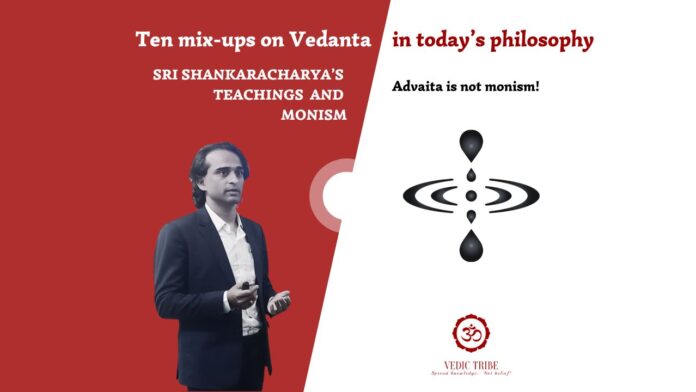Advaita, not monism!
In the previous article we discussed why Sri Madhwacharya’s teaching should be called “Tattva-vada” and not dualism. In this article, we will discuss Sri Shankaracharya’s teachings and Monism.
Sri Shankaracharya’s philosophy of Advaita Vedanta is often miscategorized as “monism.” While monism posits a single, ultimate reality, Advaita goes beyond this to assert the non-dual nature of consciousness.
What is monism?
Monism asserts that there is ultimately only one reality, one substance, or one principle. This can manifest in various forms, such as:
– Materialistic monism: Everything is matter.
– Idealistic monism: Everything is mind or consciousness.
– Neutral monism: Reality is neither purely material nor purely mental.
The Essence of Advaita:
Non-Duality: Advaita, literally meaning “non-dual,” emphasizes the oneness of all existence. It asserts that the ultimate reality, Brahman, is the sole, indivisible truth.
Illusory World: The physical world, with its myriad forms, is considered an illusion (Maya) created by Brahman. This illusion obscures the true nature of reality.
Self-Realization: The goal of Advaita is to realize one’s identity with Brahman, transcending the limitations of the individual self.
Why Not Monism?
A common analogy used to explain monism is the ocean. In this analogy, the ocean represents the ultimate reality, while the waves, currents, and ripples represent the individual entities and phenomena that arise from it, maintaining a distinct & separate identity.
The Ocean: The vast, boundless ocean is the single, ultimate reality.
The Waves: The waves, though distinct and ever-changing, are ultimately composed of the same water as the ocean.
Similarly, in monistic philosophy, individual beings and objects are seen as manifestations or expressions of the ultimate reality. They are distinct and separate from one another, yet they are all interconnected and ultimately derived from the same source.
While monism emphasizes the unity of all things, it often acknowledges the diversity and individuality of the world. This apparent contradiction is often left resolved in modern philosophy.
In contrast, Advaita denies any such distinction. It asserts that neither individual self (Atman) nor the world is separate from Brahman but different appearance of Brahman itself.
Moreover, monism often fails to account for the illusory nature of the world and the transformative power of spiritual realization. Advaita, on the other hand, provides a comprehensive philosophy with its distinct interpretation of Vedanta.
Sub-schools of Advaita:
The teachings of these sub-schools of Advaita are not shared by Monism in any sense:
Ajati vada: This sub-school of Advaita holds that the world was never created and all that we perceive is absolute illusion.
Vivarta vada: This sub-school of Advaita holds that the world is a transformation of Brahman. I.e., Brahman transforms itself to create the world (like spider creating web out of its own silk).
Drishti-Srishti vada: This sub-school suggests that the world comes into existence when individual consciousness (Jeevatma) exercises the power of perception.
Key take aways for you:
“Advaita” not monism: While studying Vedanta, if you come across the word monism, replace it with “Advaita”.
Study Advaita: Understand what “Advaita” means and study Sri Shankaracharya’s philosophy in the light of such knowledge. Instead of online search, consult a traditional Vedanta scholar who is well-versed in Sanskrit grammar, etymology…etc
In the next article, we will discuss the third mix-up – “Mind and Manas”.
Madhwesh K
Vedic Tribe

